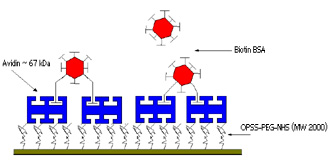
 |
|||||||
CMOS-MEMS Gravimetric Biosensor |
|||||
|
John Neumann Advisors: Gary Fedder Kaigham (Ken) Gabriel |
 Schematic showing a typical chemical treatment of a membrane with avidin (receptor) and biotin (target). The areal mass density of the CMOS-MEMS membrane is 2.6×103 ng/µm3; this is only about 200 times the areal mass density of bound biotin (1.5×10-5; ng/µm3), and much smaller than the vibrating mass in a quartz crystal microbalance. |
||||
|
Project: Gravimetric sensing of chemicals in solution has traditionally been done with a quartz crystal microbalance, which detects chemicals via the change in frequency due to mass adhering to the surface. We propose to build the same type of functionality into a CMOS-MEMS device, which would have two distinct advantages over conventional technology:
|
|||||
|
overview | projects | people | publications | intranet | resources © 1998-2009 Carnegie Mellon |